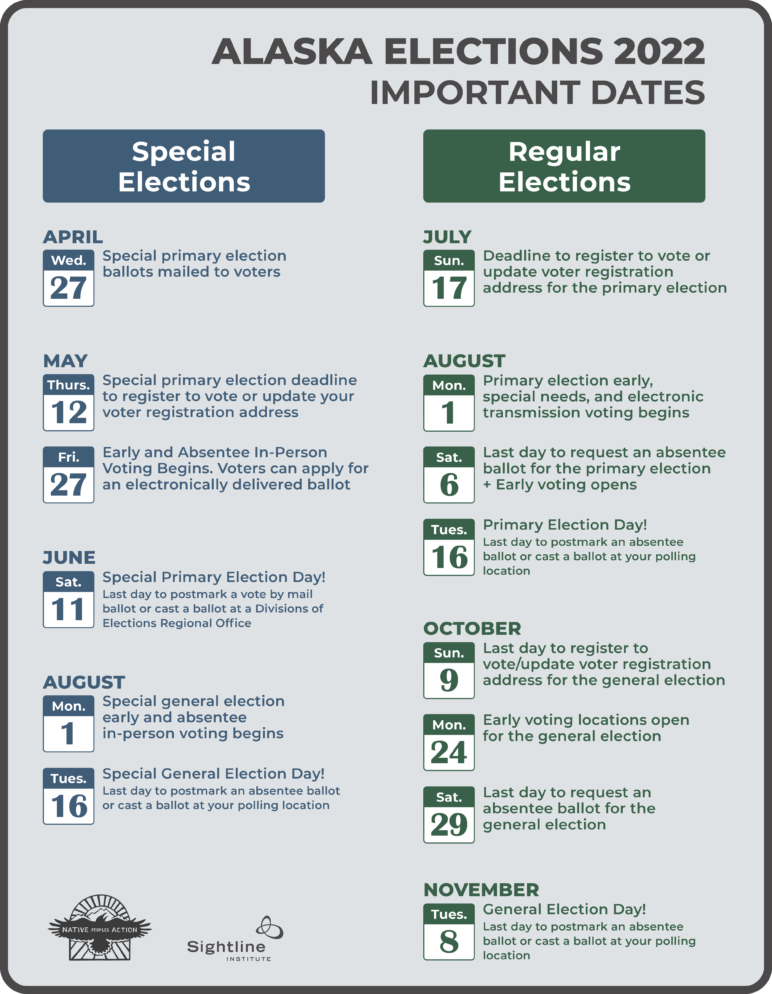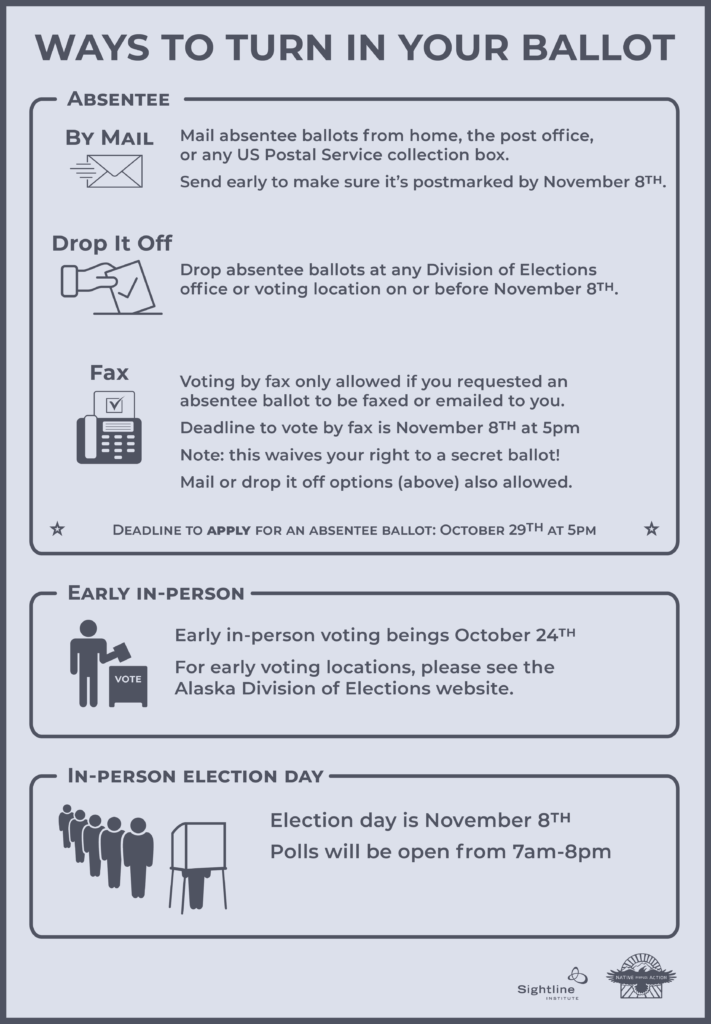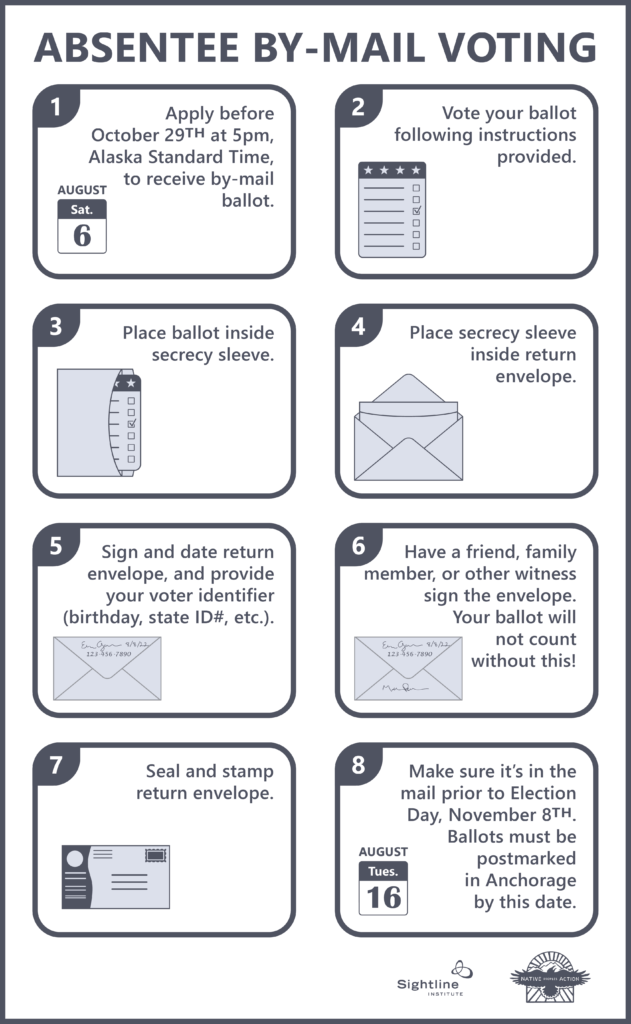Find audio versions of Sightline articles on any of your favorite podcast platforms, including Spotify, Google, and Apple.
Alaskans tried ranked choice voting for the first time in August, during the special election that sent Representative Mary Peltola to Congress. They’ll use it again during the November general election to choose their governor, Congressional members, and the state legislature.
Most voting systems in the US limit voters to just one candidate per race. But ranked choice voting allows voters to rank the candidates from most to least favorite. Ranked choice lets voters more fully express their views at the ballot box, tends to reward candidates with the widest appeal, and helps moderate candidates’ positions. Alaska voters across the political spectrum adopted ranked choice voting and open primaries in 2020.
Recent polling found that 85 percent of Alaskans who voted in the special election thought ranked choice voting was “simple.” With an even greater number of voters turning out for the November election, we want to make sure all voters feel confident filling out their ballots.
Here are answers to the top questions we’ve been hearing about Alaska’s November 8, 2022, general election.
General info on Alaska’s November 2022 elections
- What is on the ballot in November?
- How will ranked choice voting work in Alaska’s general election?
- What key election dates should I calendar?
- How do I register to vote?
- How do I check my voter registration status?
- When will election results come out?
- What is the Alaska Constitutional Convention question?
- How can I volunteer to be an election worker?
Who’s running for office in Alaska and what do they stand for?
- Who are the candidates?
- How do I learn more about the candidates and the issues?
- What do the political party labels next to each candidate’s name actually mean?
- How can I find out which candidates each political party has endorsed?
What you need to know to vote in Alaska’s general election
- What are my voting options?
- Are there voter ID requirements?
- Where do I get an absentee ballot?
- How can I turn in my absentee ballot?
- Do I need a witness signature on my absentee ballot envelope?
- If I vote absentee, can I track my ballot?
- What if I miss the deadline to request a vote-by-mail absentee ballot but need to vote absentee?
- How can I get election materials in Alaska Native languages, Spanish, Tagalog, and other languages?
- How do I fill out my ballot correctly?
- Do I have to rank every candidate?
- What are some common mistakes to avoid when ranking candidates?
- How do I replace a lost ballot?
Sightline Institute is also producing and sharing free voter education resources for Alaska at sightline.org/AlaskaVote, including graphics detailing key election dates, sample ballots, and a map of regional election offices. If you still have questions after reviewing the ones below, please don’t hesitate to email or ask Jeannette Lee on Twitter. We’ll update this article with additional information you ask for.
General information on Alaska’s August 2022 elections
WHAT IS ON THE BALLOT IN NOVEMBER?
On November 8, Alaskans will vote in the general election. They’ll use ranked choice voting to decide who represents them in the US House and Senate, the governor’s and lieutenant governor’s offices, and in the state legislature.
The pick-one primary, held in August, sent the top four candidates from each race to November’s general election. In primary races with four or fewer candidates, the whole field advanced to the November ballot.
How will ranked choice voting work in Alaska’s general election?
Voters will be able to rank the candidates in order of preference. Once the polls are closed, everyone’s first-choice vote is counted. If a candidate receives a majority (50 percent plus one) of first–choice votes, then they are the winner. If no candidate gets a majority of votes after the first round, the candidate with the fewest first-choice votes is eliminated, and his or her supporters’ votes are reallocated to the voters’ second preference. This process continues until a candidate receives a majority of the vote.

What key election dates should I calendar?
The key dates for the election are:
- Sunday, October 9: Voter registration deadline.
- Monday, October 24: Most early and in-person absentee voting locations open. Hours and days vary by location.
- Saturday, October 29: Applications for an absentee ballot delivered by mail must be received by the Division of Elections.
- Tuesday, November 8: Election Day! Polls are open from 7:00 a.m. to 8:00 p.m.

We made a free timeline of Alaska’s key 2022 election dates. It’s printable and social media-shareable. You could use it in a PowerPoint, or turn it into a fridge magnet, flyer, or poster.
How do I register to vote?
If you are an eligible voter in Alaska and applied for a Permanent Fund Dividend in 2021, you were automatically registered to vote. To check your voter registration status, go to the state’s My Voter Information page.
If you need to register or change your voter information, visit the state’s Online Voter Registration page. You must register to vote by October 9.
How do I check my voter registration status?
You can check your voter registration status here.
When will election results come out?
Alaska’s election results won’t come out right away because the absentee ballots arriving after Election Day need to be counted. These ballots come from Alaska voters outside the state, including from members of the military, snowbirds, and college students.
Under Alaska law, there’s a 15-day window after Election Day for these absentee ballots to arrive. This longstanding practice helps ensure absentee voters aren’t disenfranchised by mail delays. Other batches of late-arriving ballots will come in from remote rural precincts, where poll workers perform a preliminary hand count of ballots and call in on Election Night to report first round results only. Once those ballots arrive in Juneau, election officials scan them for the final tabulation.
Normally, later absentee votes don’t make much of a difference in results. But in a ranked choice system, they actually matter. Plus, the pandemic made absentee voting more popular, so they make up a higher percentage of submitted ballots.
Election officials plan to report first-round results soon after polls close. Then, they’ll wait for late absentee ballots to come in before reporting the final results. That means Alaskans can expect official results by November 23. (For reference, the Alaska Division of Elections chose to report the results of the August 16 US House special election on August 31.)
What is the Alaska Constitutional Convention question?
In Alaska, the “constitutional convention question” automatically appears on the ballot every 10 years. A constitutional convention is a gathering of elected delegates who propose amendments and changes to the state constitution, but it only occurs if a majority of voters think it should and vote to support it on their ballots. Alaska’s first and only constitutional convention was held in 1956.
In this year’s election, voters can indicate their support of or opposition to holding a state constitutional convention. If the ballot measure passes, Alaska will have to determine how delegates will be chosen, how much the convention will cost the state, and the processes for approving a new constitution.
How can I volunteer to be an election worker?
If you want to help make sure that Alaska has safe, fair, and efficient elections, you can sign up to be an election worker!
Who’s running for office in Alaska and what do they stand for?
Who are the candidates?
The Alaska Division of Elections list all of the candidates on its website.
How do I learn more about the candidates and the issues?
Here’s a fantastic candidate comparison tool produced by professional news organizations in Alaska.
Candidates have also participated in forums sponsored by media outlets, trade groups, and community organizations, with video available to the public from each at the links below:
- US Senate: Senator Lisa Murkowski, Kelly Tshibaka, and Pat Chesbro at an Alaska Oil and Gas Association forum
- US House: Representative Mary Peltola, Sarah Palin, and Nick Begich at an Anchorage Chamber of Commerce forum
- Governor: Governor Mike Dunleavy, former Governor Bill Walker, and former state Representative Les Gara at an Alaska Oil and Gas Association forum
The Alaska Division of Elections website also includes an Official Candidate Statement for each candidate. The Official Election Pamphlet (OEP), mailed to every voter household on Monday, October 17, also includes biographical statements prepared by candidates who elected to participate in the OEP.
Learn more about the judges on the ballot here.
What do the political party labels next to each candidate’s name actually mean?
Each candidate’s chosen political party (e.g., Democrat, Republican, Libertarian) appears in parentheses next to their name on the ballot. This means the candidate is registered with the party but does not mean the party has endorsed them.
In some cases, the candidate will have chosen not to affiliate with a party at all.
How can I find out which candidates each political party has endorsed?
You can find candidate endorsements on the websites of the Alaska Democratic Party, Alaska Republican Party, and Alaska Libertarian Party.
What you need to know to vote in Alaska’s general election
What are my voting options?
Voters can vote:
- early in person, or
- absentee, or
- in person on Election Day.

For early voting and Election Day voting locations, please see the Alaska Division of Elections website at www.elections.alaska.gov.
Are there voter ID requirements?
Yes. When voting in person, your voter ID card, driver’s license, state ID, military ID, passport, hunting or fishing license, or another current valid photo ID are all acceptable forms of ID. A current utility bill, paycheck, government check, bank statement, or other government-issued document is also acceptable.
Where do I get an absentee ballot?
Any eligible voter can request an absentee ballot. You do not need a reason. To have your absentee ballot mailed to you, you must request it by October 29. To have your absentee ballot sent to you by email or fax, you must request it by November 7. Find more information on absentee voting at the Division of Elections website.
How can I turn in my absentee ballot?
By mail: Mail your absentee ballot from home, the post office, or any US Postal Service collection box. Do it early to make sure it’s postmarked by November 8.
In person: Drop off your ballot at any Division of Elections office or voting location by 8:00 p.m. on or before November 8.
By fax: If you requested an absentee ballot to be faxed or emailed to you, you can vote by fax but are waiving your right to a secret ballot. (You can also use the by-mail or drop-it-off options noted above.) Fax your completed ballot to the number provided with your ballot before 8:00 p.m. on Election Day.

Do I need a witness signature on my absentee ballot envelope?
Yes. If your absentee ballot envelope does not have a witness signature, it will not be counted. (The Division of Elections waived this requirement in 2020 but reinstated it in 2022.) You can have a friend, family member, or other witness sign the outside of the envelope.
If I vote absentee, can I track my ballot?
You can check the status of both your absentee ballot application and your completed absentee ballot through the state’s voter information portal.
What if I miss the deadline to request a vote-by-mail absentee ballot but need to vote absentee?
You can apply for an absentee ballot to be faxed or emailed to you starting on October 24. You must send in the application by November 7, at 5:00 p.m. Your digital ballot cannot be submitted electronically; it must be printed and returned in a hard-copy form.
How can I get election materials in Alaska Native languages, Spanish, Tagalog, and other languages?
In Alaska, voters can obtain election materials and help from translators either in person or by phone in a variety of languages. The Division of Elections is communicating with voters statewide in Alaska Native languages, Spanish, Tagalog, and other languages required for Alaska by federal law. Posters, brochures, radio spots, and other translated voter information will be available as the year goes on, according to the division’s language compliance manager Samantha Mack.
In writing
Voter registration applications: Available in Tagalog, Spanish, six Yup’ik languages (General Central Yup’ik, Norton Sound Kotlik Yup’ik, Yukon Yup’ik, Hooper Bay Yup’ik, Bristol Bay Yup’ik, Chevak Cup’ik), Nunivak Cup’ig, Unangam Tunuu, and Gwich’in.
Absentee ballot applications: Available in Tagalog, Spanish, six Yup’ik languages, Nunivak Cup’ig, Unangam Tunuu, and Gwich’in.
Sample ballots: Available in Tagalog, six Yup’ik languages (see above), Nunivak Cup’ig, Gwich’in, Inupiaq (Northern), and Unangam Tunuu.
Real ballots: The actual ballots will all be in English. In precincts with electronic voting tablets, translated audio is typically available in Spanish, Tagalog, six Yup’ik languages (see above), Nunivak Cup’ig, Gwich’in, and Inupiaq. Voters are allowed to use sample ballots as an aid.
Official election pamphlets: Available in Tagalog and Alaska Native languages. The division will mail the Alaska Native language versions of the pamphlets direct to voter households this year, in addition to the usual household mailings of the Tagalog version. The division for the first time will also allow voters to bring the pamphlets to polling places.
Election glossaries: The division is issuing updated elections glossaries for all Yup’ik languages as well as Gwich’in. The update includes terms and phrases related to ranked choice voting. These glossaries are complete and will be available on the Division’s website. An Unangam Tunuu elections glossary is in the works.
Ranked choice voting FAQ: Available online in six Yup’ik languages, Spanish, Tagalog, Nunivak Cup’ig and Gwich’in.
PowerPoint presentation: The division is translating a printable PowerPoint presentation about the new election system into all languages typically provided by the division.
In person
On election days (primary and general), on-call interpreters and bilingual registrars, outreach workers, and poll workers will be available in certain communities based on the availability of poll and outreach workers.1
Voters may have a person of their choice provide assistance as long as that person is not a candidate, their employer, an agent of their employer, or an agent of their union. The voter’s assistant may go into the voting booth to help the voter cast their ballot.
By phone
Voters may call a toll-free language assistance number on or before Election Day: (866) 954-8683 or (907) 275-2333.
Radio
Public service announcements are airing in Tagalog, Spanish, six Yup’ik languages, and Gwich’in, and the division is working on more in Inupiaq and Unangam Tunuu. The PSAs cover registration deadlines, candidate deadlines, list maintenance, accessibility assistance, availability of the Official Election Pamphlet, the dates of elections, and when voting will occur. PSA audio and written text will also be available on each language’s respective webpage.
By mail
The division is sending translated mailers direct to voter households and to tribal councils.2
Videos
The division has translated educational videos about the new election system on its website and YouTube. The division plans to share the videos on social media in conjunction with Alaska Native regional corporations and other community organizations, including Get Out the Native Vote.
Mock elections
Alaska’s mock election educational tool, including detailed results and explainers, is available in more than two dozen languages, including several Alaska Native dialects.
How do I fill out my ballot correctly?
Rank the candidates from most- to least-favorite. You can preview sample ballots for the general election at the Division of Elections website.
Do I have to rank every candidate?
No. That being said, you should try to rank at least two. If you choose only one candidate and do not rank anyone second, you will be throwing away the chance to weigh in on the rest of the field. Other voters will be making a choice without you.
What are some common mistakes to avoid when ranking candidates?
Filling out your ranked choice ballot the wrong way means you risk spoiling your general election ballot. Either your vote won’t count, or you’ll end up effectively voting for just one candidate, rather than having your vote redistributed to your next-favorite candidate(s).
1. Do not rank a candidate more than once. Your vote will not count for that candidate more than once.

2. Do not give the same ranking to more than one candidate.

3. Do not skip rankings.

As a reminder, here’s the example ballot from above, with the correct way to indicate your preferences when you ranked choice vote.

How do I replace a lost ballot?
Lost your ballot? Contact any Division of Elections office to request a replacement ballot for the special primary election. The deadline to ask the division to email you a new ballot is November 7 at 5:00 p.m.
What’s Next?
Go vote!


